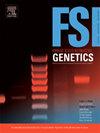Denoising of microhaplotype MPS data using DADA2 and its application to two-person DNA mixture analysis
IF 3.1
2区 医学
Q2 GENETICS & HEREDITY
引用次数: 0
Abstract
With the advent of phase-known sequencing enabled by massively parallel sequencing (MPS), research on microhaplotypes (microhaps), multi-single nucleotide polymorphisms within short DNA fragments, has advanced significantly in forensic genetics. However, MPS data inherently contains PCR and sequencing errors, presenting challenges in distinguishing minor contributor alleles from background noise in DNA mixture analysis. Divisive Amplicon Denoising Algorithm 2 (DADA2) has been widely used in microbial research for inferring amplicon sequence variants (ASVs) through computational error correction. However, its potential applicability to forensic identity testing has not been fully explored. In this study, we redesigned an in-house MPS panel targeting 24 multipurpose microhaps and established a pipeline employing DADA2’s ASV inference algorithm to denoise microhap MPS data. Denoising performance was evaluated using 1 ng of DNA from 50 single-source samples. The average not suppressed noise level decreased from 1.2 % to 0.1 % after denoising, achieving a genotype concordance rate of 99.5 % with undenoised data. However, DADA2 had difficulty in distinguishing heterozygous alleles differing only by single indel. In two-person DNA mixture analysis, DADA2-denoising pipeline reduced the number of noise haplotypes by 10-fold across various ratios (1:10, 1:20, 1:50, and 1:100) using 1 ng of total DNA. Even at a 1:100 ratio with 10 pg of minor DNA, noise was detected in only two or fewer markers among the 24 microhaps. These findings highlight the potential of computational error correction for enhancing the accuracy of detecting minor alleles and estimating the number of contributors in forensic analyses.
DADA2微单倍型MPS数据去噪及其在二人DNA混合分析中的应用
随着大规模平行测序(MPS)技术的出现,对微单倍型(microhaplotypes,即短DNA片段内的多单核苷酸多态性)的研究在法医遗传学领域取得了重大进展。然而,MPS数据固有地包含PCR和测序错误,在DNA混合物分析中从背景噪声中区分次要贡献等位基因提出了挑战。分裂扩增子去噪算法2 (DADA2)已广泛应用于微生物研究中,通过计算误差校正来推断扩增子序列变异(asv)。然而,它在法医身份鉴定中的潜在适用性尚未得到充分探索。在这项研究中,我们重新设计了一个内部MPS面板,针对24个多用途微hap,并建立了一个管道,使用DADA2的ASV推理算法对微hap MPS数据进行降噪。从50个单源样本中提取1 ng的DNA来评估去噪性能。去噪后,平均未抑制噪声水平从1.2 %下降到0.1 %,与去噪数据的基因型一致性率为99.5 %。然而,DADA2很难区分单基因杂合等位基因。在双人DNA混合分析中,dada2去噪管道在不同比例(1:10,1:20,1:50和1:100)下,使用1 ng的总DNA,将噪声单倍型的数量减少了10倍。即使在1:100的比例下,10 pg的小DNA,在24个微可能中只有两个或更少的标记被检测到噪音。这些发现强调了在法医分析中提高检测次要等位基因的准确性和估计贡献基因数量的计算纠错的潜力。
本文章由计算机程序翻译,如有差异,请以英文原文为准。
求助全文
约1分钟内获得全文
求助全文
来源期刊
CiteScore
7.50
自引率
32.30%
发文量
132
审稿时长
11.3 weeks
期刊介绍:
Forensic Science International: Genetics is the premier journal in the field of Forensic Genetics. This branch of Forensic Science can be defined as the application of genetics to human and non-human material (in the sense of a science with the purpose of studying inherited characteristics for the analysis of inter- and intra-specific variations in populations) for the resolution of legal conflicts.
The scope of the journal includes:
Forensic applications of human polymorphism.
Testing of paternity and other family relationships, immigration cases, typing of biological stains and tissues from criminal casework, identification of human remains by DNA testing methodologies.
Description of human polymorphisms of forensic interest, with special interest in DNA polymorphisms.
Autosomal DNA polymorphisms, mini- and microsatellites (or short tandem repeats, STRs), single nucleotide polymorphisms (SNPs), X and Y chromosome polymorphisms, mtDNA polymorphisms, and any other type of DNA variation with potential forensic applications.
Non-human DNA polymorphisms for crime scene investigation.
Population genetics of human polymorphisms of forensic interest.
Population data, especially from DNA polymorphisms of interest for the solution of forensic problems.
DNA typing methodologies and strategies.
Biostatistical methods in forensic genetics.
Evaluation of DNA evidence in forensic problems (such as paternity or immigration cases, criminal casework, identification), classical and new statistical approaches.
Standards in forensic genetics.
Recommendations of regulatory bodies concerning methods, markers, interpretation or strategies or proposals for procedural or technical standards.
Quality control.
Quality control and quality assurance strategies, proficiency testing for DNA typing methodologies.
Criminal DNA databases.
Technical, legal and statistical issues.
General ethical and legal issues related to forensic genetics.

 求助内容:
求助内容: 应助结果提醒方式:
应助结果提醒方式:


